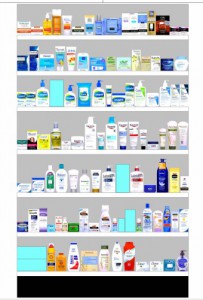By Kyle Lentz for our “99 Ways to Make a Positive Difference in Your Pharmacy” blog series
This is part one of a two-part blog series covering how HRG builds their planograms and why it’s important for independent pharmacies to follow them to maximize profits.
Implementing planograms assures that you have the right mix of products, in the right positions, with the proper amount of facings to accurately fulfill the needs of most of your customers. When we say most, we typically mean 85-90% of the people shopping your pharmacy. There is so much behind-the-scenes work that goes into creating a planogram that you would be remiss if you didn’t take advantage of the six month process it takes to create your desired planogram size.
Each planogram is created with a specific percentage of items that fulfill the needs of each subcategory within that department. Take the Cold & Allergy category for instance. Within this category, there are seven general subcategories that represent 100% of department sales. Each of these subcategories represents a certain percentage. Some represent a greater percentage, some less, but each are equally important to the decision-making process, and ultimately, the planogram.
We use several data sources to help make planogram decisions. Our primary data source is wholesaler withdrawal data. Hamacher receives this data from over 65 distribution centers across the U.S. and it is exclusive to us. Our secondary source is Information Resources, Inc. or IRI®. The third and fourth sets of data we use come directly from manufacturers and through trade publications. And finally, we visit anywhere from 10 to 15 stores, for each category, from mass marketers like Wal-Mart and Target, to chain stores like Walgreens and CVS, plus grocery outlets and independent pharmacies. Our analysts build an extensive knowledge base prior to ever arranging a single product in a planogram. We do this because our category review team takes no slotting fees or manufacturer dollars for placement in planograms. We are completely objective.
Keeping with the Cold & Allergy category as an example, we then download the data for all 1,950 products we have in our master database that are classified as a Cold & Allergy product. We separate them into their subcategories and rank the items based on unit sales, dollar sales, and profitability. Our goal is to find not only the products that move well in retail outlets but will also give our retail partners the biggest bang for their buck. These items are called Never Outs®. Never Outs are items that can contribute up to 50% of category sales and are present in every size planogram we create. Once these products are determined, we start to arrange them in planograms.
Stop back to read my next post where I will cover the remaining steps in the process of creating a category planogram for independent pharmacy.
Kyle is a category analyst for our core TEMPS program, and a member of our new item alert team. He supports national wholesale accounts and works directly with manufacturers, distributors, and retailers to analyze client-specific data and develop specialized planogram solutions.
